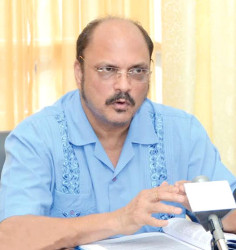The adequacy of the government’s response to the mosquito-borne Zika virus became an issue of contention when the debate of the proposed national budget continued in the National Assembly on Tuesday evening.
The government of Guyana has repeatedly claimed that it is leading an aggressive campaign to eradicate the Aedes Aegypti mosquito and thereby arrest the spread of the virus, which has been linked to brain damage in newborns but according to the opposition the administration is not doing enough.
Former Minister of Health Dr Bheri Ramsaran told the House that despite the large provisions for health in the budget, the funds that will actually be used for fighting Zika is minuscule.

“The response to this emerging pandemic is poor. Only two regions—not the central ministry—have made provisions for fogging machines. Destruction of the vector, the mosquito, should be a key provision but there is nothing for vector control. That is a sick situation,” Ramsaran declared.
Zika is transmitted when an Aedes mosquito bites a person with an active infection and then spreads the virus by biting others. Though only one in four persons bitten develop symptoms of Zika those people then become carriers during the time they have symptoms.
The Ministry of Public Health recently released a schedule for fogging in Georgetown and parts of the East Coast and East Bank Demerara and has committed to having fogging exercises done in all ten administrative regions.
This, however, has not impressed Ramsaran, who accused the administration of plagiarising plans developed under his tenure and failing to add anything to reflect the new challenges faced by the health sector.
“All they are using is what the PPP administration left. They are not developing, not adding anything to these programmes,” he said.
According to the former minister, spray cans provided by former Minister of Local Government Norman Whittaker to the 65 NDCs, as a start to their vector control programmes in 2014, are still being used with no additional equipment budgeted for. Even the two fogging machines budgeted for in regions One and Ten are bundled, he claimed, “with about 14 other items” so that the actual available funds for their purchase will be minuscule.

He urged the government to spend some of the $4 billion windfall from falling oil prices to fight Zika by buying fogging machines, spraying, and distributing treated mosquito nets and repellent free of cost to pregnant women in the first instance and then to all Guyanese women of childbearing age.
In her response to Ramsaran, Minister within the Ministry of Public Health Dr Karen Cummings told the House that the ministry is about to launch an aggressive public awareness and education campaign to combat this virus.
She noted that in addition to the continued distribution of treated mosquito nets to pregnant women, there are plans for a pilot project using the In2Care mosquito Traps in selected public health care facilities and ministries in Georgetown.
In the long term, she noted, efforts will be made in collaboration with Caricom and Brazil to build capacity at the National Reference Laboratory to test for the Zika virus locally rather than send samples to the Trinidad-based Caribbean Public Health Agency (CARPHA).
According to Cummings, the short and medium term provisions can be realised with resources the ministry already possesses.
Guyana registered its first and only confirmed case of Zika in early January. Since that time samples sent to CARPHA have not shown the presence of the virus.
The Zika virus is related to Yellow Fever, West Nile, Chikungunya and Dengue but no treatment or vaccine exists yet for it.
Before 2015, it was a relatively unknown virus existing within the regions of Africa and Asia. However, since then, it has been aggressively travelling through the Americas.
Major concerns about Zika arose after it became linked to several neurological diseases. Brazil has reported a growing number of cases of women delivering babies with microcephaly – incomplete brain development – believed to be linked to the virus. PAHO notes that while the country has between 2010 and 2014, reported a yearly average of 163 microcephaly cases there have been between October 2015 and the first week of this year 3,530 microcephaly cases recorded. These cases include 46 deaths, in 20 states and the Federal District. There is also evidence which links Zika to the Guillain-Barré syndrome which results in adult paralysis, mostly temporarily. A number of these cases have been seen in Colombia.
In a January 24 statement, PAHO/WHO explained that Zika which has been linked to neurological diseases in both newborns and adults is most effectively prevented by “reducing mosquito populations by eliminating their potential breeding sites, especially containers and other items (such as discarded tires) that can collect water in and around households; and using personal protection measures to prevent mosquito bites.”
As the disease and its effect continue to spread across the Americas, the WHO has declared a Public Health Emergency of International Concern and efforts are presently being expanded to develop a vaccine as well as to research the relationship between the virus and the diseases to which it has been linked.





